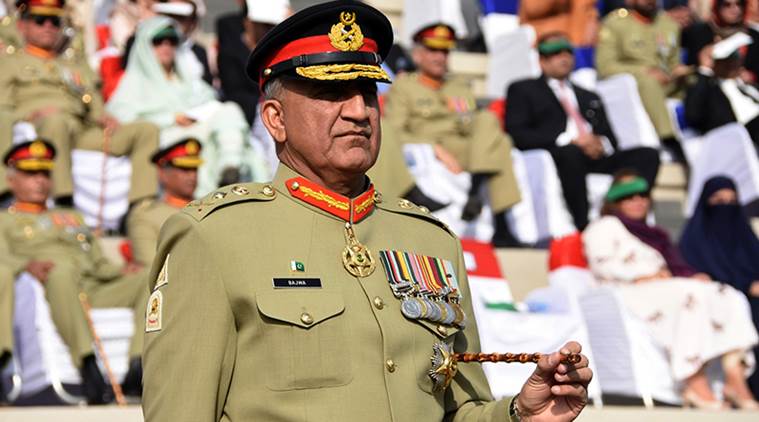
Lt General Faiz Hameed is the third ISI chief appointed by Pakistan Army chief General Qamar Javed Bajwa. Soon after becoming chief on November 26, 2016, Bajwa had appointed Lt General Naveed Mukhtar (Armoured Corps) as the ISI Chief on December 11, 2016, in place of Lt General Rizwan Akhtar (Frontier Force), who was shifted out prematurely.
Following Mukhtar’s retirement in October 2018, Lt Gen Asim Munir (Frontier Force) was appointed DG ISI. Barely eight months into his tenure, Munir has been shifted out as Corps Commander Gujranwala. Hameed has been appointed as DG ISI in his stead. Both Hameed and General Bajwa are from the Baloch regiment. Like Munir, who had headed military intelligence, Hameed too has intelligence experience, having headed the internal security wing of the ISI.
Bajwa had hand-picked Munir as DG ISI. He had served as Force Commander Northern Areas (FCNA) when Bajwa was Corps Commander X Corps. To understand the reasons for the sudden curtailment of his tenure, several dots, both external and internal, need to be connected.
The Pulwama terror strike in February 2019 took place when Munir was DG ISI. There is a realisation in Pakistan and in the international community that the incident could have precipitated a major clash between India and Pakistan. Following the Balakot air strike, there is recognition of the fact that India, under Prime Minister Narendra Modi, will not turn the other cheek but take the battle into Pakistan. The doctrine of pre-emption articulated by the Indian foreign secretary also makes it more likely that India will hit back in the future too. This view has been bolstered with PM Modi’s massive victory in the recently-concluded elections. With a renewed and larger mandate, PM Modi will be in a stronger position to retaliate against any adventurism indulged in by Pakistan.
Against this backdrop, according to a report in this newspaper, Pakistan is said to have shared information on a possible terrorist attack in Pulwama district, probably near Awantipora using a vehicle-borne improvised explosive device (VBIED). The attack is supposedly to avenge the killing of Zakir Musa in the Tral area by Indian security forces last month. Musa had broken away from the Hizbul Mujahideen in May 2017 and launched and headed an al Qaeda affiliate called Ansar Ghazwat-ul-Hind.
Pakistan sharing such information with India is intriguing. It could either be a case of ensuring that it is not blamed in case of an attack; or since it is an al Qaeda linked group, Pakistan is not really concerned if the attack was foiled. The latter is difficult to believe since any violence in Kashmir is seen positively in Pakistan.
At this stage, another major terrorist attack in India does not suit Pakistan. Given how Pulwama could have led to disaster and the fact that the US, Saudi Arabia and China had prevailed upon Pakistan to de-escalate the crisis by releasing the captured Indian pilot, it is clear that even Pakistan’s remaining friends will not look kindly at a similar kind of attack. Hence, the information would have been reluctantly shared with India.
It is quite likely, therefore, that Munir is being held responsible for not keeping the jihadi flock in control and potentially putting Pakistan in grave danger. Despite all its bluster and bravado, Pakistan is not looking for a clash with India at this stage. Its plate is already full with a fragile economy desperately in need of bailouts, pressures from the Financial Action Task Force (FATF), internal unrest in the Pashtun areas, among other issues. The last thing it would want at this juncture is giving India a pretext to retaliate again with deep strikes inside its territory.
There are also important internal developments that Lt General Hameed may be able to handle better. He played an important role in defusing the 2017 Faizabad dharna of the Barelvi outfit, Tehreek-i-Labbaik Pakistan (TLP). He was also instrumental in ensuring Imran Khan’s “victory” in the July 2018 elections. With the economy in dire straits and opposition parties gearing up to destabilise the government, the internal “security” expertise of the new DG ISI could come in very handy to ensure the health of the Imran Khan government.
Another critical issue is the clumsy manner in which the Pashtun protests have been dealt with. The Pashtun Tahafuz Movement (PTM) has been growing in strength and its call to end violence and harassment in the former Federally Administered Tribal Areas (FATA) has been getting traction among the Pashtuns in Pakistan. The army sees its latest slogan, lar-o-bar yaw Afghan — the spectre of the merging of Pakistani Pashtun (lar) with their Afghan brethren (bar) within a so-called Greater Afghanistan — as indicative of secessionist tendencies. Given that about 20 per cent of the Pakistan army consists of Pashtuns, the PTM could pose a clear and present danger.
Lt General Hameed’s task is cut out. He has to ensure that things do not get out of control internally in Pakistan. However, as far as India is concerned, the lull — if one can call it that — would only be temporary till the situation cools down. Once international pressure eases, the Pakistan economy is under an IMF programme and the threat of being blacklisted by the FATF recedes, it will be back to business as usual for the new DG ISI.
Devasher is the author of Pakistan: Courting the Abyss and Pakistan: At the Helm. He is a former Special Secretary, Cabinet Secretariat, Government of India andis currently member, National Security Advisory Board and consultant, Vivekananda International Foundation